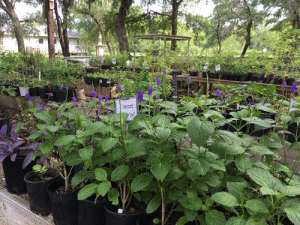It’s that time of year again! Spring! The land reawakens from the dormancy of winter and new growth bursts forth. This is the perfect time to bring new greenery into your own gardens and yards! There are many reasons why and how we plan our landscaping, but I propose that you go “wild” this year. Wildscaping that is!
My Gulf Coast Bird Observatory colleague wrote a previous article talking about how you can make your gardens more friendly to birds and other wildlife through the use of native plants and other features. Now, I would like to narrow in on the native plant side of this proposal.
Wildscaping is a hybrid of horticulture and ecology, meaning a garden that imitates aspects of the native eco-system and translates them into an urban setting. Thus, the great thing about wildscaping is its versatility. It can be as simple as having a few potted nectar plants on a porch, or as complex as landscaping your entire yard with many varieties of pollen, nectar, and leaf food sources.
Besides attracting and supporting native wildlife, wildscaping has the added benefits of reducing the need for water and artificial fertilizer. This results in lower water bills and costs for yard maintenance. Plants native to our portion of Texas have adapted to the timing of the seasons, harshness of the weather, and water availability we experience. They have a high tolerance for poor soil and are more likely to survive the environmental extremes of our area without the need for additional protection. Native plants are also typically adapted to surviving local pests and, therefore, do not need chemical pesticides.
When designing your wildscape, there is a large variety of native plants from which to choose. By adding a range of native plants, you can ensure there is something blooming throughout every season to provide for wildlife year-round. In addition to being aesthetically pleasing, a variety of shapes, colors, and sizes incorporated into a wildscape also helps support a wide variety of wildlife.
An excellent one-stop shop for all of your native plant needs is the Gulf Coast Bird Observatory native plant nursery! The nursery is a self-guided retail space and plant propagation area, emphasizing local native and other naturalized plants useful for wildscaping. The nursery is volunteer-run and friends of GCBO are encouraged to help by bringing in seeds or plants which may be worthy of propagation.
The unique and ever-evolving inventory of the GCBO plant nursery gives visitors a wide variety of plants to choose from. Unique offerings vary, but may include many of the local pollinator-supporting plants such as Blue Mistflower, Swamp Sunflower, Tropical Sage, and native Hibiscus species. Woodland or shade-tolerant wildflowers such as Turk’s Cap, Heartleaf Skullcap, and Gulf Coast Penstemon may also be found here. We include many flowering understory trees such as Cherry Laurel, Persimmon, and hawthorns, along with canopy trees such as Live Oaks. Other offerings include Common Snowdrop, Scarlet Freesia, Virginia Creeper, Wood Ferns, Blue Iris, Mesquite Trees, Seaside Goldenrod, and Brazoria Palms.
GCBO specialties include many rare and unusual varieties of Turk’s Cap and Porterweed found nowhere else. Look for our locally developed hybrids denotated as “Bayou …” in honor of the adjacent Buffalo Camp Bayou. We encourage you to take a look around the native plant nursery, on your next visit to GCBO, for unique species you may want to incorporate into your own backyard.
Photo: Blue Mistflower Credit: GCBO
Photo: GCBO Native Plant Nursery Credit: GCBO


